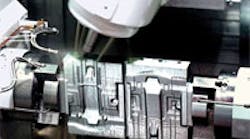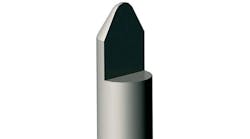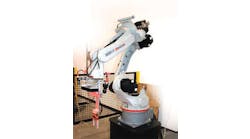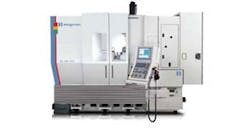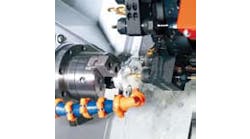By John Teresko | Industry Week
The early enthusiasm for multi-tasking machine tools is finding growing rationale far beyond the obvious attraction of “done on one.”
That versatility factor will continue to draw -- after all, who can resist considering a multi-tasking contender where four such units have been known to replace as many as 20 conventional machines, asks Brian Papke, president of Florence, Ky.-based Mazak Corp., the U.S. operations of Japan’s Yamazaki Mazak Corp. Papke can’t -- he attributes the performance of his manufacturing operations, no surprise, to the use of Mazak multi-tasking equipment.
In addition to reducing costs by enabling one machine to do the work of several, multi-tasking is motivating the rethinking of factory layout and operations, product design and machine tool features in general, adds Papke. “For example, one result is a new emphasis on machine intelligence.”
The direction of his thinking is reflected in Mazak’s product introductions at the EMO Hannover 2007 machine tool show, held in September in Hannover, Germany. More than half of Mazak’s 20-some machine introductions are in the company’s Integrex family of multi-tasking designs, says Papke.
Why so many multi-tasking introductions?
“Customers are looking for suppliers that can meet a wide variety of multi-tasking opportunities.”
In multi-tasking, fewer machines are needed and that means fewer tools, operators and all of the means necessary to move parts between machines. The parts produced are inherently more accurate as one set of fixtures and one machine tool reduce the errors and tolerance stack-up due to multiple setups.
Papke says that at the user level, the process simplification made possible by multi-tasking offers an opportunity to improve both product characteristics and assembly by designing fewer, albeit more complex parts. With multi-tasking machines, part complexity doesn’t carry the cost penalty of the conventional manufacturing approach, explains Papke.
He also claims that today’s multi-tasking machines don’t have the performance borders of the technology’s early years.
“For example, at Mazak, at Terry Yamazaki’s direction, the design intent is to avoid multi-tasking performance compromises. A multi-tasking machine is expected to mill like a machining center and turn like a turning center.”
Time savings can be significant with multi-tasking. Overall cycle time is reduced as a result of eliminating the non-value-added activities of multiple setups, locating tools and moving parts to machines. For example, one multi-tasking machine could substitute for a sequence of processing on a combination of vertical turning lathes, horizontal machining centers, vertical machining centers and in some cases radial arm drill presses, says Papke. Setting up the part in each machine not only takes significant amounts of time, it introduces variations that must be corrected and compensated for.
Controlling part manufacturing in one machine with a single set of fixtures can greatly reduce the possibility of rework and scrap while holding tighter tolerances.
Multi-tasking machines also reduce work-in-process, the pile of parts that accumulate between operations on the factory floor, adds Papke. Since small lot sizes become more practical, the temptation to produce just-in-case inventory is minimized.
With that enhanced capability, Papke predicts smaller plant floors and a new significance for the “right” operator training. Ironically, he also notes that overall, fewer machines will be sold. He also expects that multi-tasking, now a machine category, will spread to becoming a characteristic or features of virtually all machine tools.
